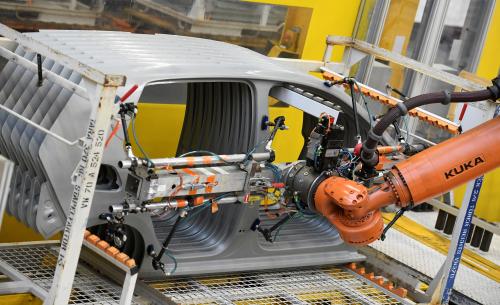The opinions expressed in this article are those of the authors. They are not intended to represent the positions or opinions of the WTO or its members and are without prejudice to members’ rights and obligations under the WTO.
Does trade hurt employment in advanced economies? Certainly that is the view of politicians who blame trade for the decline of manufacturing. If nothing else, their political success has sounded a wake-up call in the research community to address the question. It is not, however, a simple one to answer.
The impact of international trade on employment and wages depends crucially on the nature and evolution of value chains, as we argue in a new study. Production has become increasingly fragmented in recent decades. Firms have unbundled their factories and outsourced production stages across the globe. This has major implications for the interactions between international trade and domestic labor markets – and also helps to put into perspective the results of a series of alarming empirical studies blaming trade for manufacturing job losses.
Three reasons value chains matter for jobs:
Value chains influence the relationship between trade and employment in three main ways:
1. Indirect exposure to trade impacts. More developed value chains mean that downstream customers and upstream suppliers are affected much more by trade. This means that trade shocks reverberate more widely through the economy. For instance, when an industry shrinks because of foreign competition, this will hurt upstream supplier industries, and the suppliers’ suppliers. Downstream customers, on the other hand, could benefit from cheaper inputs that foreign competition implies. Input-output linkages between industries, and the specific position of industries in the value chain, determine in part the effect of trade on labor markets. In several advanced economies, more than half of the jobs supported by exports are not within exporting establishments but within supplier establishments:
2. International competition in specific production stages, rather than whole sectors. The stretching of value chains allows for cross-border competition at a finer-grained level, in terms not of entire sectors, but of specific tasks. This has serious implications for skill demand within countries; since different stages often require very different levels of skills. Value chains allow these stages to be unbundled spatially, so that countries well-endowed in skilled (unskilled) labor can specialize in skill (unskilled)-intensive stages. As a result, aggregate skill demand within a country can shift much more dramatically than for traditional trade competition. This contributes to the polarization of the labor market, and specifically a decline in the number of middle-skill jobs relative to low- and high-skill jobs, that can be observed in most developed countries:[1]
3. Trade statistics can become misleading. The globalization of value chains undermines the informational value of traditional gross trade statistics, and their connection to labor market impacts. This is because they mis-measure the scale and scope of import competition. For example, if firms offshore their assembly stages but keep their upstream production stages within the country, gross import statistics will be calculated on the basis that the complete value chain was offshored, and therefore heavily overstate import competition.
What do value chains mean for domestic jobs and inequality?
A comprehensive overview of the impact of trade on labor markets therefore requires a proper consideration of the role and importance of value chains. Two key lessons emerge. First, trade is likely to raise aggregate employment, even if modestly, as well as real wages. Cost savings resulting from cheaper imports and greater export opportunities create employment in many sectors of the economy that do not trade directly but nonetheless benefit from trade through input-output linkages. Even within the manufacturing sector, the value chain perspective suggests a more benign impact of trade than the popular perception. Once the rise of value chains is properly accounted for, it looks as if trade has contributed at most a relatively small share to the decline of manufacturing employment in advanced economies.
Second, trade has, however, contributed to regional and individual disparities within countries. Since industries tend to cluster regionally, the impact of trade is very heterogeneous across geographic areas. While trade benefits labor markets in regions with exporting industries and industries that rely on imported inputs, it might hurt regions that compete directly with foreign producers. Similarly, the growing premium on individual skills has been accelerated by the rise of value chains, resulting in wider disparities between the skilled and unskilled.
Job-friendly policies for a trading world
How should policymakers respond?
Not by restricting trade. With global value chains, it has become harder to use trade policy to reduce economic shocks, because the implications for employment have become more complex and difficult to assess. While trade restrictions, for example in the form of safeguards, can help domestic firms to adjust by temporarily limiting import competition and increasing their share in the domestic market, they also penalize export-oriented industries and industries that benefit from cheaper inputs. Tariffs on imports of intermediates can increase the sourcing cost of domestic exports and thereby worsen their competitiveness.
Instead, the goal of policy should be to offer broad adjustment support, increase skills, and support specific regions or cities.
- General adjustment assistance. Narrowly defined “trade adjustment” support is hard to target in a world of more fragmented value chains. It is difficult for adversely affected workers in upstream or downstream firms to qualify for specific adjustment assistance, reducing the policy’s effectiveness. Although specific adjustment policies (e.g., the US Trade Adjustment Assistance program) do attempt to cover workers from first-tier upstream or downstream producers, they fail to account for linkages further up or down the value chain. More general adjustment policies could reach these workers. Non-specific adjustment policies can also support workers adversely affected by technological change and other shocks that are difficult to disentangle from, similar to and easy to confuse with those induced by trade. The scale and scope of these kinds of labor market policies differs widely across advanced economies:

- Training and education. Traditionally, countries specialized in industries in which they were most competitive. Before the age of value chains, it was easier to transition from sunset to sunrise sectors. Displaced workers might benefit from employment subsidies or job search assistance. Today workers may face deeper difficulties when their skill set becomes obsolete. Therefore, training assistance programs are therefore increasingly important forms of adjustment policy. The most effective policies promote skills that are relevant for multiple industries, increasing workers’ flexibility and resilience in an unpredictable job market.
- Place-based policies. As well as helping individuals adjust, policymakers should consider helping particular places to adjust. This is especially true when trade effects vary dramatically between regions. A value chain perspective can help to identify these varying effects with more accuracy, thereby helping with the design of appropriate adjustment policies. Mobility and place-based policies are the instruments of choice to address regional disparities in adjustment costs.
International trade is good. It is good not only for consumers but also workers. Right now, this is not the commonplace view. We need better communication on the benefits of trade. But we also need to be vigilant about important differences in the costs and benefits of trade between places and people. Taking value chains into account can help shape and direct policy so that the benefits of trade are shared more broadly still.
[1] Beverelli, C., Rubinova, S., Stolzenburg, V. and Woessner, N. (2018), ‘Did Global Value Chains contribute to rising labour market polarization?’, WTO, unpublished manuscript.







Commentary
Workers of the world, embrace your value chains
April 18, 2019